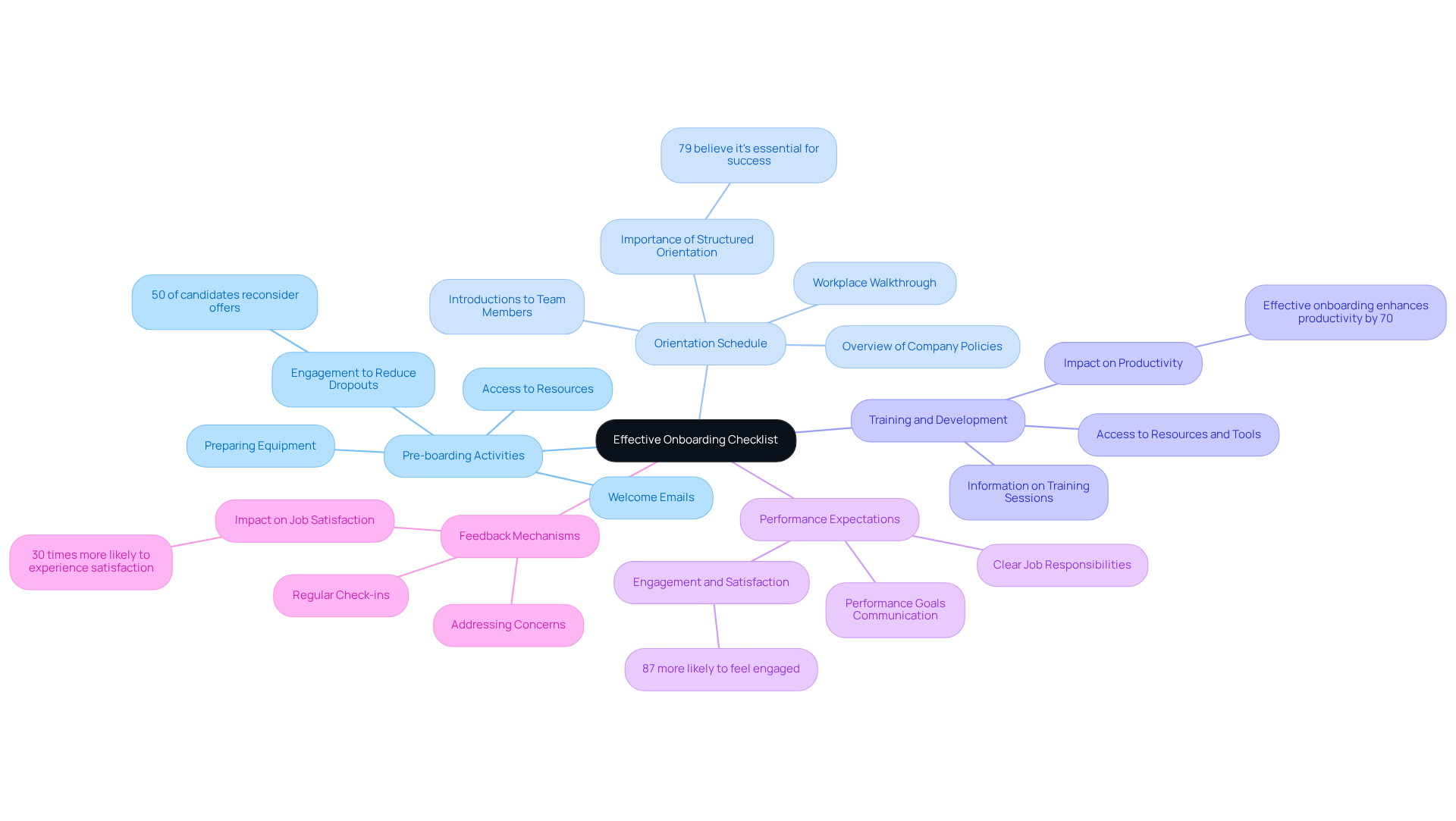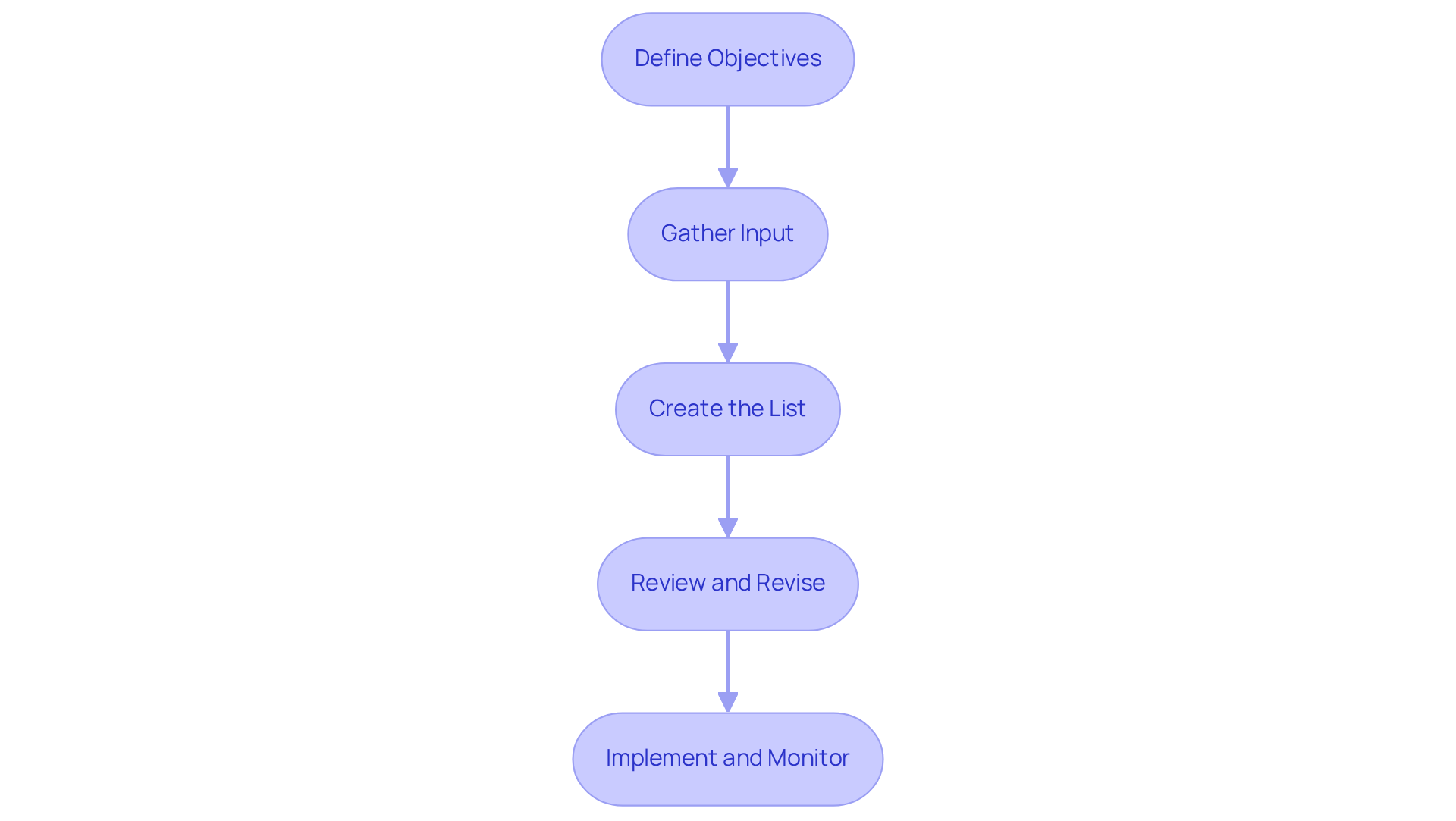
Streamlined Onboarding Processes
|
October 16, 2025
|
4 Steps to Create an Onboarding Checklist for Managers
Overview
You might be wondering how to make the onboarding process smoother for new employees. Well, this article dives into creating an effective onboarding checklist just for managers! It highlights some key components like:
- Pre-boarding activities
- Orientation schedules
- Training resources
- Performance expectations
- Feedback mechanisms
By having a structured onboarding process in place, you can really boost employee retention and engagement right from the start, offering them clear guidance and support. Now, let’s explore how these elements work together to make everyone’s experience better!
Key Highlights:
- An onboarding checklist serves as a roadmap for new employees, aiding in their integration into company culture and understanding of roles.
- Implementing a checklist can reduce the chances of overlooking critical tasks, leading to smoother transitions and improved employee engagement.
- Research indicates organised orientation programmes can boost employee retention rates by up to 25%.
- Key components of an effective onboarding checklist include pre-boarding activities, an orientation schedule, training and development resources, performance expectations, and feedback mechanisms.
- Pre-boarding activities like welcome emails and equipment preparation can reduce candidate reconsideration rates.
- A detailed orientation schedule helps new hires feel welcomed, with 79% of staff believing it is essential for success.
- Providing training resources can enhance productivity by about 70%.
- Clearly communicating job responsibilities increases employee engagement and satisfaction by 87%.
- Feedback mechanisms, including regular cheque-ins, are vital for ensuring new hires feel supported and satisfied.
- Steps to create an onboarding checklist include defining objectives, gathering input, creating the list, reviewing, and monitoring its effectiveness.
- Utilising tools such as document management systems, communication platforms, and feedback tools can streamline the onboarding process and enhance employee engagement.
Introduction
Creating a successful onboarding experience is crucial for organizations looking to boost employee engagement and retention. You might be wondering how an effective onboarding checklist can help with that. Think of it as a strategic tool for managers that streamlines the integration process, ensuring new hires feel welcomed and ready to hit the ground running from day one.
But here’s the catch: crafting a checklist that not only covers the essentials but also aligns with your organization’s unique culture and goals can be a bit tricky.
So, how can managers develop a comprehensive onboarding checklist that meets these needs while enhancing the overall employee experience? Let’s dive into it!
Understand the Purpose of an Onboarding Checklist
You might be wondering how a new employee guide can really make a difference, right? Well, think of it as an essential roadmap for newcomers, guiding them through those crucial early days and weeks in the organization. This structured approach is all about ensuring that they get integrated into the company culture, have a clear understanding of their roles, and are equipped with the resources they need to succeed.
Now, here’s where it gets interesting: by implementing a comprehensive checklist, managers can significantly cut down on the chances of overlooking critical tasks. This leads to a smoother transition for new employees. Not only does this improve their introduction experience, but it also helps foster a sense of belonging and engagement from day one—something that's super important for long-term retention and productivity.
Did you know that research suggests organizations with organized orientation programs can boost employee retention rates by as much as 25%? That really highlights the importance of investing in effective training strategies! When newcomers feel supported and informed, they’re much more likely to stick around and contribute positively to the organization's goals. So, let’s dive into how we can make these orientation processes even better!

Identify Key Components of an Effective Onboarding Checklist
An effective onboarding checklist should cover some key components that really make a difference:
- Pre-boarding Activities: You might be wondering what happens before the new employee's first day. Well, this is where the magic starts! Think about sending welcome emails, preparing necessary equipment, and granting access to essential resources. Engaging candidates during this phase can significantly reduce the chances of them backing out—did you know that 50% of candidates have accepted offers but later reconsidered? By using SowFlow's Instant Documentation Solution, you can ensure that all pre-boarding materials are easily accessible, making new employees feel valued and ready to go.
- Orientation Schedule: Now, let’s dive into the first day agenda. A detailed schedule is crucial! It should include introductions to team members, an overview of company policies, and a walkthrough of the workplace. A structured orientation helps new employees feel welcomed and integrated into the company culture, which 79% of staff believe is essential for their success. With SowFlow's solution, you can provide instant access to orientation materials, ensuring that all necessary information is right at their fingertips.
- Training and Development: Next up, let’s talk about training. Providing information on training sessions, resources, and tools that the new employee will need is vital. Effective onboarding can enhance productivity by about 70%, so it’s super important to give new employees the right training from the start. Using SowFlow's Instant Documentation Solution, managers can simplify access to training materials and standard operating procedures, ensuring that new employees have everything they need at their fingertips.
- Performance Expectations: Clearly communicating job responsibilities and performance goals is another key step in setting the new employee up for success. Employees who understand their roles are 87% more likely to feel engaged and satisfied with their jobs, which is critical for retention. SowFlow's solution can help document these expectations clearly and make them readily available for reference.
- Feedback Mechanisms: Lastly, let’s not forget about feedback. Implementing regular check-ins to assess the new hire's integration and address any concerns they may have is essential. Ongoing feedback is crucial because research shows that employees with excellent introductory experiences are 30 times more likely to experience job satisfaction. By ensuring that documentation is readily available, SowFlow's solution facilitates smoother communication and feedback, tackling the challenges posed by scattered information across platforms.
By incorporating these elements and leveraging SowFlow's Instant Documentation Solution, managers can create a comprehensive orientation guide that guarantees a seamless transition for new employees. This ultimately leads to higher retention rates and enhanced productivity—who wouldn’t want that?

Follow a Step-by-Step Process to Create Your Checklist
To create an effective onboarding checklist, you’ll want to follow these essential steps:
- Define Objectives: So, what are the goals of your induction process? Think about what you want new employees to achieve in their first few weeks. Research shows that a well-defined onboarding process can significantly boost employee retention and engagement. This step is crucial, trust me!
- Gather Input: Have a chat with team leaders and current employees to identify the information and resources that new hires typically need. This collaborative approach ensures that your checklist addresses real needs and expectations. After all, who knows better than those already in the trenches?
- Create the List: With all that valuable insight, it’s time to whip up a comprehensive list that includes all the necessary tasks and timelines. For example, including specific objectives like completing training modules or meeting key team members can provide clarity and direction. It’s all about setting them up for success!
- Review and Revise: Once you’ve got a draft, share it with stakeholders for feedback. This step is vital for ensuring clarity and completeness. Input from different perspectives can really shine a light on areas that might need improvement.
- Implement and Monitor: Now that you’ve finalized the checklist, it’s showtime! Apply it during the induction process and keep an eye on its effectiveness. Be open to making adjustments based on feedback from new employees and supervisors. A smooth integration experience can turn this process into a competitive edge—companies that excel in employee assimilation outperform their rivals financially by 89%!
By following these steps, you’ll create a structured orientation checklist that not only welcomes new employees but also sets them up for success right from day one. Sounds good, right?

Leverage Tools and Resources for Efficient Onboarding
To enhance the efficiency of your onboarding process, you might be wondering how an onboarding checklist for managers can be a valuable tool and resource that makes a difference. Let's dive into a few options that could streamline your efforts:
- Employee Integration Tools: Have you checked out platforms like BambooHR and Gusto? They come with integration modules that automate tasks and keep tabs on progress, making the transition for new hires feel seamless and smooth.
- Document Management Systems (DMS): Tools like SowFlow are a game-changer! They let organizations create, manage, and share introductory documents and checklists with ease. Plus, SowFlow's unique features, like instant access to recorded workflows in a collaborative workspace, help cut down on mistakes and speed up retrieval times. Did you know that the average retrieval cost for a lost paper document is $120? That's a solid reason to consider a DMS!
- Communication Tools: Using platforms such as Slack or Microsoft Teams can really boost interaction between new employees and their teams. It helps build relationships right from day one, making the overall integration experience much better.
- Feedback Tools: Ever thought about using survey tools like SurveyMonkey? They’re perfect for gathering valuable feedback from new hires about their integration experience. This feedback is crucial for ongoing improvements and ensuring the onboarding process meets the needs of your new team members.
Incorporating these tools into your onboarding checklist for managers can create a more streamlined and effective training experience. Ultimately, this results in higher retention rates and happier employees. As industry experts point out, structured onboarding practices significantly enhance employee engagement and satisfaction, making a strong case for adopting DMS like SowFlow. So, why not explore these options further?

Conclusion
Creating an onboarding checklist for managers isn’t just a procedural task; it’s a strategic move that can really enhance the integration experience for new employees. You might be wondering how a simple checklist can make such a difference. Well, by establishing a clear and comprehensive checklist, organizations can ensure that newcomers feel welcomed into the company culture, understand their roles, and have the resources they need from day one. This structured approach not only boosts engagement but also plays a crucial role in improving retention rates and overall productivity.
So, what should an effective onboarding checklist include? Think of:
- Pre-boarding activities
- A detailed orientation schedule
- Training and development resources
- Clear performance expectations
- Mechanisms for ongoing feedback
Each of these elements helps new hires transition smoothly, making them feel valued and ready to succeed in their new roles. Plus, leveraging tools like document management systems and communication platforms can really streamline the onboarding process, ensuring that all necessary information is easily accessible and that new employees feel supported throughout their journey.
Ultimately, the importance of an effective onboarding checklist can’t be overstated. It’s a vital tool for managers looking to enhance employee satisfaction and retention, leading to a more engaged and productive workforce. By prioritizing the onboarding experience and utilizing the right resources, organizations can create a competitive edge that not only attracts talent but also keeps it. Embracing this approach can truly transform the onboarding process into a powerful driver of organizational success. So, why not start crafting that checklist today?
Frequently Asked Questions
What is the purpose of an onboarding checklist?
The purpose of an onboarding checklist is to serve as a roadmap for new employees, guiding them through their early days and weeks in the organization. It helps integrate them into the company culture, clarifies their roles, and equips them with necessary resources for success.
How does an onboarding checklist benefit new employees?
An onboarding checklist benefits new employees by ensuring a smoother transition into the organization, improving their introduction experience, and fostering a sense of belonging and engagement from the start.
What impact does a comprehensive onboarding process have on employee retention?
Research suggests that organizations with organized orientation programs can boost employee retention rates by as much as 25%, highlighting the importance of effective training strategies.
Why is it important for new employees to feel supported during onboarding?
When newcomers feel supported and informed during onboarding, they are much more likely to stay with the organization and contribute positively to its goals.
👍
What others are liking
5 Steps to outline your ideal documentation structure
5 MINS READ
Where to start the your journey of mapping out your ideal documentation structure, aligning it with the very heartbeat of your organization?
Defining a winning level of detail in your process
3 MINS READ
What is too much detail, and what is too little? This article described in that winning level detail about what detail is enough.





